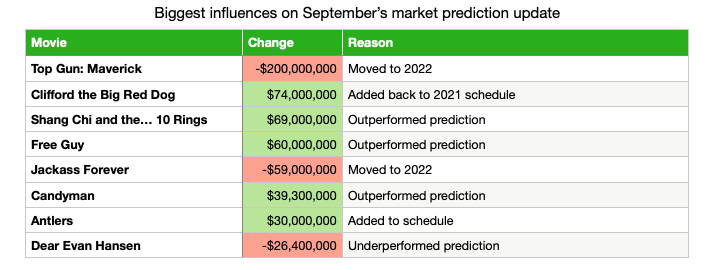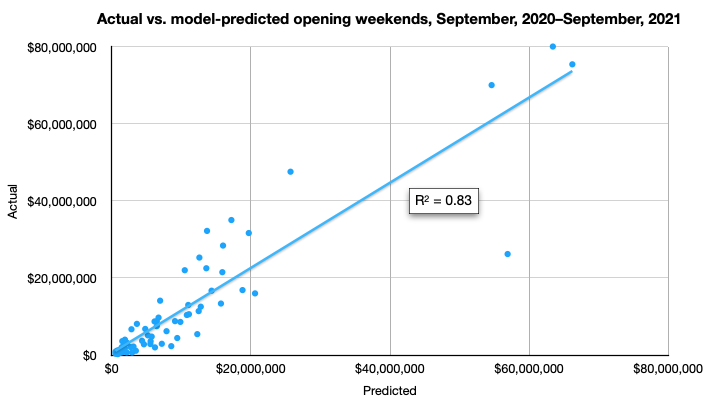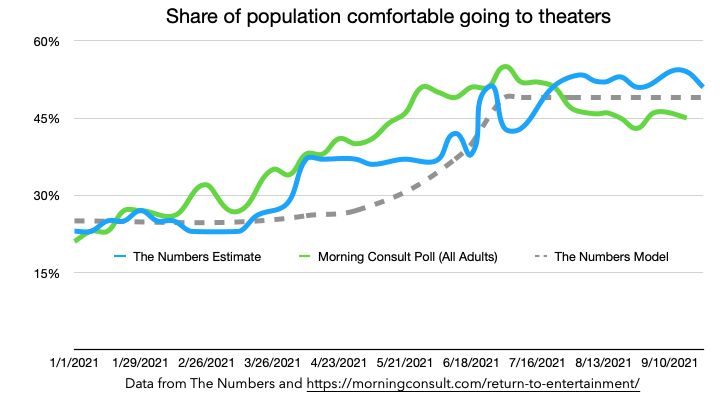2021 market forecast: our market prediction holds steady(-ish) at $4.6 billion, but Warner Bros.’ releases are the big unknown
September 27, 2021
While Shang-Chi and Free Guy have been posting excellent box office earnings over the past month or so, there’s no denying that September has been a tough month for the theatrical business. The combined box office for all films released during the month looks like it’ll settle at slightly over $300 million domestically, and Shang-Chi will be responsible for over $200 million of that. October should be much less dependent on one film, with Venom: Let There Be Carnage, No Time to Die, and Dune all likely to top $100 million, hopefully with ease. Exactly how easily they do so could have a big effect on the final box office tally for 2021, particularly if they manage to make audiences more comfortable with coming to theaters again.
One question hangs over everything, though. How will Warner Bros.’ continued hybrid release strategy affect the box office performance of Dune? I’ll dig into what the model thinks about that at the end of the article, but first here’s where the market prediction stands as of today…
This time last month, our model forecast a $4.7-billion year at the domestic box office. Although September proved to be challenging, the prediction is changing only very slightly this month, to $4.6 billion. That’s partly because Shang-Chi’s performance made up for the generally weak earnings for other films released in September. In fact, the model now gives Shang-Chi the highest predicted gross for any film released this year, with a projected $229 million by the end of its run.
Note that’s not quite the same thing as saying Shang-Chi is probably going to be the highest-grossing film this year. There’s a very high probability that one of the remaining 2021 releases will beat it, but it’s hard to be sure which one. Spider-Man: No Way Home has the best chance, according to the model, but there are still five or six films that are in the running for that particular prize.
One of the reasons the model is quite cautious about its predictions through the end of the year is that audience enthusiasm has been quite muted in recent weeks…
As expected, the share of the population comfortable going to theaters remained basically flat throughout September, both based on box office results compared to our model, and on Morning Consult’s polling. As of today, our model’s estimate is that the audience is 51% of pre-pandemic levels. Morning Consult’s most recent survey says that 45% of all adults are comfortable going to a movie theater. Both numbers have been stuck around that 50% line for a while.
The prediction for the rest of the year assumes that we’ll start to see that number pick up over the next few weeks, relatively modestly at first, but then accelerating into November before settling down at 70% by the end of the year. That movement is built on the assumption that people will feel more comfortable going to theaters as the Delta variant wave of COVID cases ebbs away. If that happens, we should see increasingly solid earnings for films going through the rest of the month.
The biggest blow to 2021’s box office prospects in the last month was, without question, the delay in the release of Top Gun: Maverick, which would almost certainly have been one of the top-grossing films of the year. That alone reduced the market projection by $200 million. The re-datings of Clifford the Big Red Dog and Jackass Forever more-or-less cancel one another out, and the fact that the market prediction only ended up falling by $100 million this month is down to the strong performances of Shang-Chi, Free Guy, and (to a lesser extent) Candyman.
One thing you might notice about the list above is that it doesn’t include any films from Warner Bros.. That might seem strange given that the underperformance of Warner Bros. releases has been a big topic of conversation in recent weeks. However, the model was never very high on the box office potential of Malignant and Cry Macho. So, even though they continued a string of poor box office results for the studio, they didn’t drag down the overall market projection very much.
However, Warner Bros. does have some very high-profile releases between now and the end of the year, and if they perform much worse than expected that would drag down the entire market. So this month I’ll dig into the recent results from the studio and try to figure out if the box office (as many people believe) is being dragged down by the simultaneous availability of their films on HBO Max.
In order to see how well Warner Bros. films have been doing recently we first have to answer the question, “compared to what?”
I’m going to take a straightforward approach to this by comparing the studio’s results to our model’s predictions. If our model is reliable, then a studio whose films consistently fall below the model’s predictions is probably underperforming at the box office. Here’s a snapshot of how accurate our model has been at predicting opening weekend box office during the pandemic.
Given how hard it has been to make predictions over the past year, I’m happy with how our model has performed. An R2 of 0.83 is often described as being “83% accurate.” That doesn’t mean the model will always come close to predicting the actual box office for a movie (see its $50 million-plus prediction for The Suicide Squad in the lower right corner of the chart, for example), but that it’s almost always in the right ballpark. (If you’re into statistics, you’ll also be glad to hear that its predictions are also “normally” distributed in the mathematical sense, and exactly 50% of its predictions have been too high and 50% too low.)
Given that the model is fairly reliable, looking at the performance of Warner Bros.’ hybrid releases should tell us something about how the studio’s films are performing at the box office when they are also available on HBO Max. But this is where the analysis gets tricky.
Warner Bros. has now released 13 films simultaneously in theaters and on HBO Max. Of those, five have over-performed compared to our model and eight have under-performed. That’s not a particularly unusual result: if you tossed a coin 13 times and got five heads and eight tails you might think yourself a bit unlucky if you called heads every time, but statistically it’s about in line with what’s normal. A more formal analysis using what’s known as Student’s t-test says that Warner Bros.’ results for all hybrid releases combined is almost completely (94% to be precise) compatible with hybrid releases having no impact at all on the opening weekend box office for the films.
However, since the beginning of August the studio has had a horrible run at the box office, with four straight films earning less than half of what our model expected on opening weekend. That’s not like flipping four tails in a row, but more like rolling four dice and having all of them come up a 1 or a 2. That’s really quite unlikely—around a 2% chance on a t-test, in fact.
If I try to rationalize these results, a plausible scenario is that the early hybrid releases boosted box office a bit because the films got free publicity as movie news focused on the unusual strategy. As these releases become less newsworthy, and more people have signed up for HBO Max (in part to watch a film like In the Heights or Godzilla vs. Kong at home), the simultaneous availability has begun to drag down the opening weekend performance of the more recent releases.
Overall, Warner Bros.’ movies have opened at 84% of what the model has predicted this year, and there’s a good argument for adjusting our weekend opening prediction down by 16% for a film like The Many Saints of Newark in response. I’m not yet convinced that such an adjustment is warranted for all Warner Bros. films though—maybe The Suicide Squad’s performance was just an aberration and Reminiscence, Malignant and Cry Macho would have opened at about the same level regardless of their availability at home.
If Many Saints comes in well below expectations this weekend, I think the case for making a general adjustment for films released simultaneously in theaters and at home will be strong. The arrival of Dune in domestic theaters at the end of October will be the ultimate test of Warner Bros.’ day-and-date strategy, though. Maybe new HBO Max subscriptions will more than make up for losses at the box office. The model says that $50 million would be about par for the course for the film on opening weekend. I’ll be joining the rest of the industry in looking very closely at the actual numbers when the film is released.
Our market prediction is based on the same model as the weekend predictions that we’ve been running since theaters started reopening towards the end of last year. We are now running the prediction model for every announced wide release on the release schedule and estimating the size of the market as a whole by assuming a relatively small amount of additional revenue from limited releases. The prediction for each movie is based on four factors:
The performance of similar films in recent years, and cast and crew Bankability. So far as possible, the model uses films in the same genre released by the same distributor as points of comparison. The predicted performance of franchise films is based on previous releases in the franchise. Cast and crew Bankability is weighted more heavily for non-franchise than for franchise films.
The current state of the theatrical market. We update our model after each weekend with a wide release to estimate what proportion of formerly-regular moviegoers are currently going to theaters. As of today, that figure is 51%. We also monitor Morning Consult’s weekly survey of moviegoers, and may make adjustments to our analysis if our number varies significantly from theirs.
Adjustments for specific genres. The pandemic has affected different segments of the audience in different ways. We are currently using four categories of movie in our model: “date night” films (which are doing worse than the general market), action movies (which are doing slightly better), family films, and “everything else” (which includes drama, comedy, and horror movies, among others). Family films seemed to be doing the best in the early stages of the recovery but are now performing much more like other genres.
The expected recovery of the theatrical market as the pandemic is brought under control. The model assumes that the market will settle back to 70% of its pre-pandemic size at the end of the recovery. Growth will be slow at first, accelerate as more people become confident in going to theaters, and then slow down as more cautious moviegoers take time to return to attending. This is the classic ''S-shaped'' curve seen in economics textbooks (and in many cases in the real world). (For more on this see my previous article, How quickly can the box office recover?) The model assumes that this recovery started on April 1, plateaued in July due to the wave in COVID in infections caused by the Delta variant, and will start again when cases wane at the beginning of October. Those parameters are likely to be adjusted as the market situation evolves.
- Current release schedule
Bruce Nash, bruce.nash@the-numbers.com


The Warner Bros. factor


Methodology
- Recent release schedule changes
- Subscribe to the Bankability Index for full details on our market predictions



-5-News.jpg)
